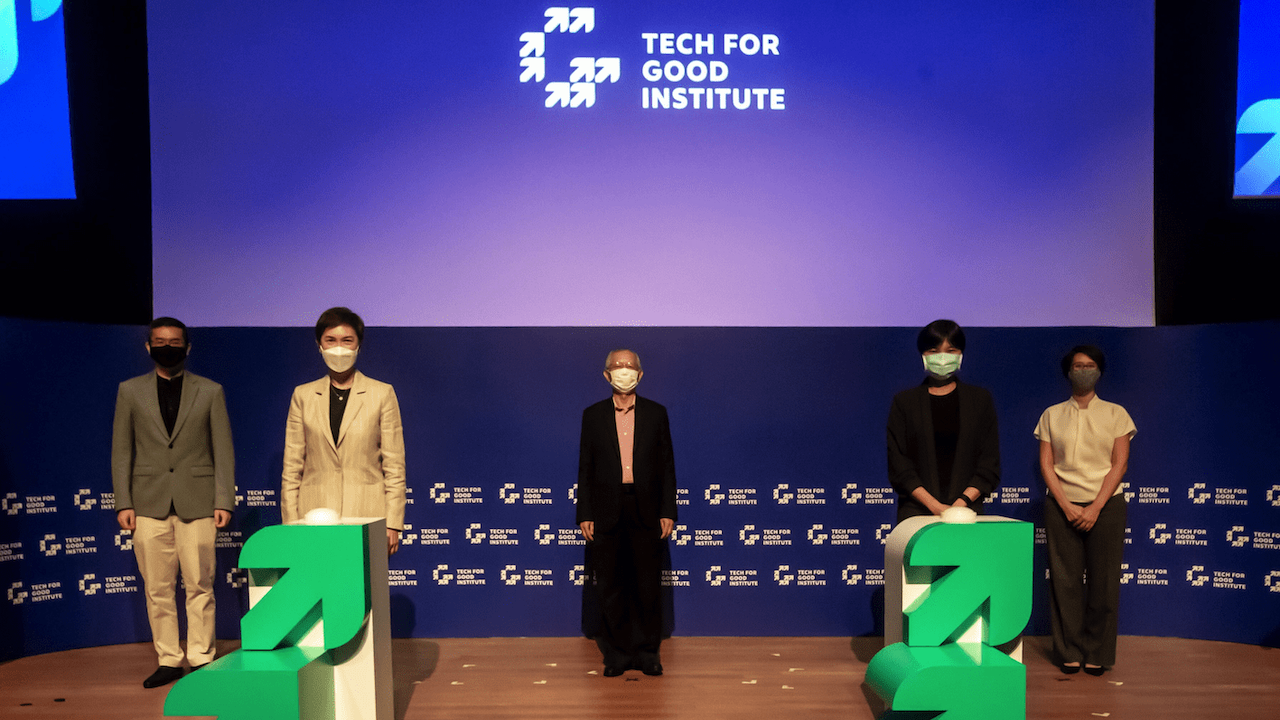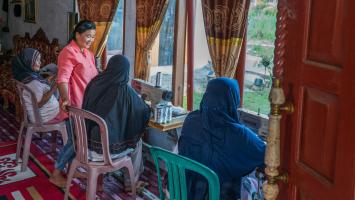
(From left: Lew Chuen Hong, CEO, Infocomm Media Development Authority; Josephine Teo, Singapore Minister for Communications and Information; Lim Siong Guan, professor, Lee Kuan Yew School of Public Policy and advisor at GIC and the Tech for Good Institute; Tan Hooi Ling, co-founder, Grab; and Ming Tan, executive director designate, Tech For Good Institute, at the Tech for Good Institute launch event. Photo credit: Courtesy of Grab.
Nonprofit think tank to drive research and dialogue around Southeast Asia’s digital economy.
This article is published in collaboration with Grab.
E-commerce platform Grab recently announced the launch of Tech For Good Institute, a nonprofit think tank established to advance research and dialogue on Southeast Asia’s fast-growing digital economy. The institute also released its inaugural report, Platform Economy: Southeast Asia’s Digital Growth Catalyst, in partnership with Bain & Company.
Digital adoption in Southeast Asia has risen sharply in recent years. The pandemic added more than 100 million new digital platform users in Indonesia, Malaysia, the Philippines, Singapore, Thailand, and Viet Nam (SEA-6). However, as digitalization accelerates, the region will have to find solutions to tackle the digital divide, ensure better protection for informal workers, and improve data privacy protection.
The institute seeks to be the region’s thought-leadership platform for the public and private sector to jointly study, discuss, and develop capabilities to enhance policy understanding and design. It aims to help harness the positive impact of technology in society and address key issues. The 4 October launch was graced by guest of honor, Singapore Minister for Communications and Information Josephine Teo.
The institute features a bench of independent advisors including Asian Development Bank Vice-President for Knowledge Management and Sustainable Development Bambang Susanto, Mae Fah Luang Foundation Secretary General Veerathai Santiprabhob, Mastercard Chief Administrative Officer Timothy Murphy, Lee Kuan Yew School of Public Policy Professor Lim Siong Guan, Research Council of Enterprise Development Foundation's (Vietnam) Vu Tien Loc, Sea Indonesia Chairman Pandu Sjahrir, Sinovation Ventures Chairman and CEO Kai-Fu Lee, and VIDA CEO Sati Rasuanto.
“Technology has brought boundless opportunities but also new challenges that we must address together as an industry. With Southeast Asia’s digital economy still in its infancy, there is no better time than now for the public and private sectors to come together to jointly drive greater digital inclusion for the region. We are grateful for the advisors who have joined us on this journey,” said Hooi Ling Tan, Grab co-founder.
“As well-established engines of economic activity, O2O [online-to-offline] platforms have the greatest potential to narrow the digital divide and break the cycle of poverty for Southeast Asia’s 150 million adults, or 31% of the population, who remain digitally excluded. This is why it’s especially encouraging to see first-generation platform companies like Grab taking the lead to establish the Tech for Good Institute which will bring together governments, civil society, and the private sector to creatively push the boundaries of how to apply their technology, data, talent, and ecosystems for good. Mastercard is delighted to contribute to the development of the institute which will help millions of underserved to find pathways to prosperity, driving financial inclusion across the region,” said Rama Sridhar, executive vice-president, Digital & Emerging Partnerships and New Payment Flows, Asia Pacific, Mastercard.
Impact of O2O platforms in Southeast Asia
Southeast Asia is at the forefront of O2O platform development. Eighty percent of internet users across Southeast Asia’s six largest markets have transacted on at least one O2O platform in the last 12 months.
The institute’s first report looks at the impact of O2O platforms on consumers and micro, small and medium-enterprises (MSME) in the region, and identifies areas to improve accessibility of these platforms. Key findings include:
Consumers
- Southeast Asia now has 310 million O2O users. However, with only 1 in 3 using three or more online-to-offline services today, there is still huge potential to deepen consumer participation in platforms.
- 8 in 10 consumers agreed that platforms have brought a positive impact in their quality of life, such as greater convenience, better price comparisons, and a wider range of options as compared to their offline purchasing experiences.
- Southeast Asian consumers value access to choice, with at least 70% of users saying that they use and switch between two or more platforms for online purchases. Ninety percent of users intend to continue using platform services post-pandemic.
MSMEs
- More than 80% of MSMEs said that platforms are critical for their future success.
- 85% of those surveyed highlighted that platforms provide reach to a larger customer base online, and 73% indicated that it is more profitable to sell through platforms, compared to offline or in-store.
- O2O digital platforms have also created a path for greater financial inclusion for MSMEs. Seventy-four percent of MSMEs who use digital lending services were previously unable to secure loans from banks and lenders.
The overall platform economy
- Based on Bain and the institute's first 2021 New Economy Progress Index, SEA-6 has made great strides in digital infrastructure development. According to the report, 1 in 2 of the SEA-6 population aged 18 and above have adopted mobile internet and digital payments.
- However, the region is still in the early stages of development. More can be done to develop physical infrastructure such as increasing coverage of same-day delivery and mobile internet speed, particularly in non-urban regions.
- While O2O adoption grew among consumers and MSMEs, penetration of online spend is still low. Online food delivery and e-commerce contributes to only 8% of total retail sales in 2020.
- The region also has a budding tech ecosystem that needs to be nurtured. Homegrown first-generation platforms have employed more than 120,000 talents since their inception, and their alumni have gone on to found more than 1,000 new start-ups, contributing to the growth of the region’s digital economy.
Florian Hoppe, partner and head of Asia Pacific Digital Practice, Bain & Company, said: “O2O platforms have been a core part of Southeast Asia’s growth. These companies have helped to bridge both physical and digital infrastructure gaps that have persisted in the region for years. It’s therefore unsurprising that most of Southeast Asia’s technology unicorns today are O2O platforms in nature, a trend that is unlike that of US and Europe. The better platforms and governments work together, the brighter the future of Southeast Asia’s digital economy.”
This story was first published by Grab on 4 October 2021.

Grab
Grab is a leading superapp in Southeast Asia, operating across the deliveries, mobility and digital financial services sectors. It serves more than 700 cities in eight Southeast Asian countries—Cambodia, Indonesia, Malaysia, Myanmar, the Philippines, Singapore, Thailand, and Vietnam.

